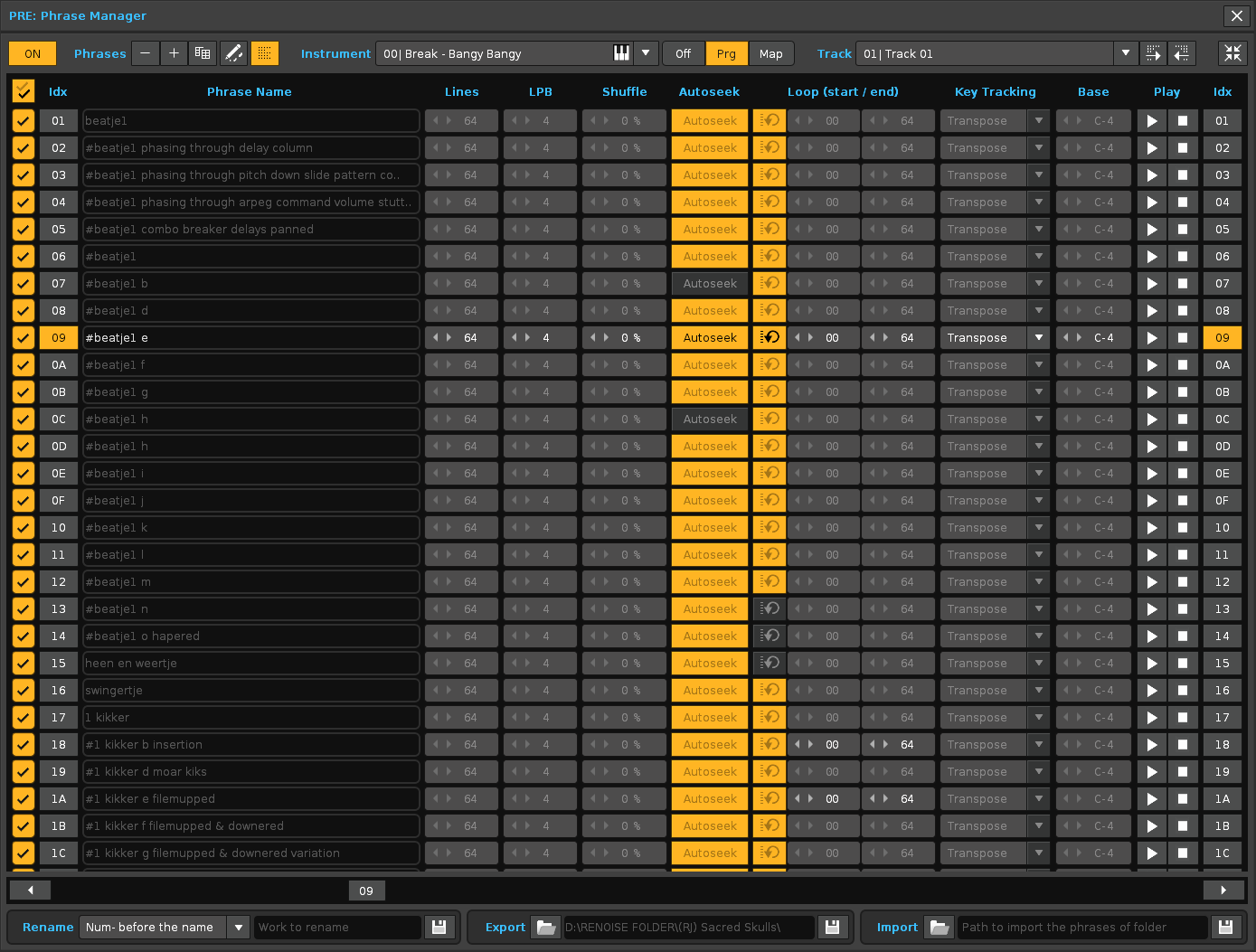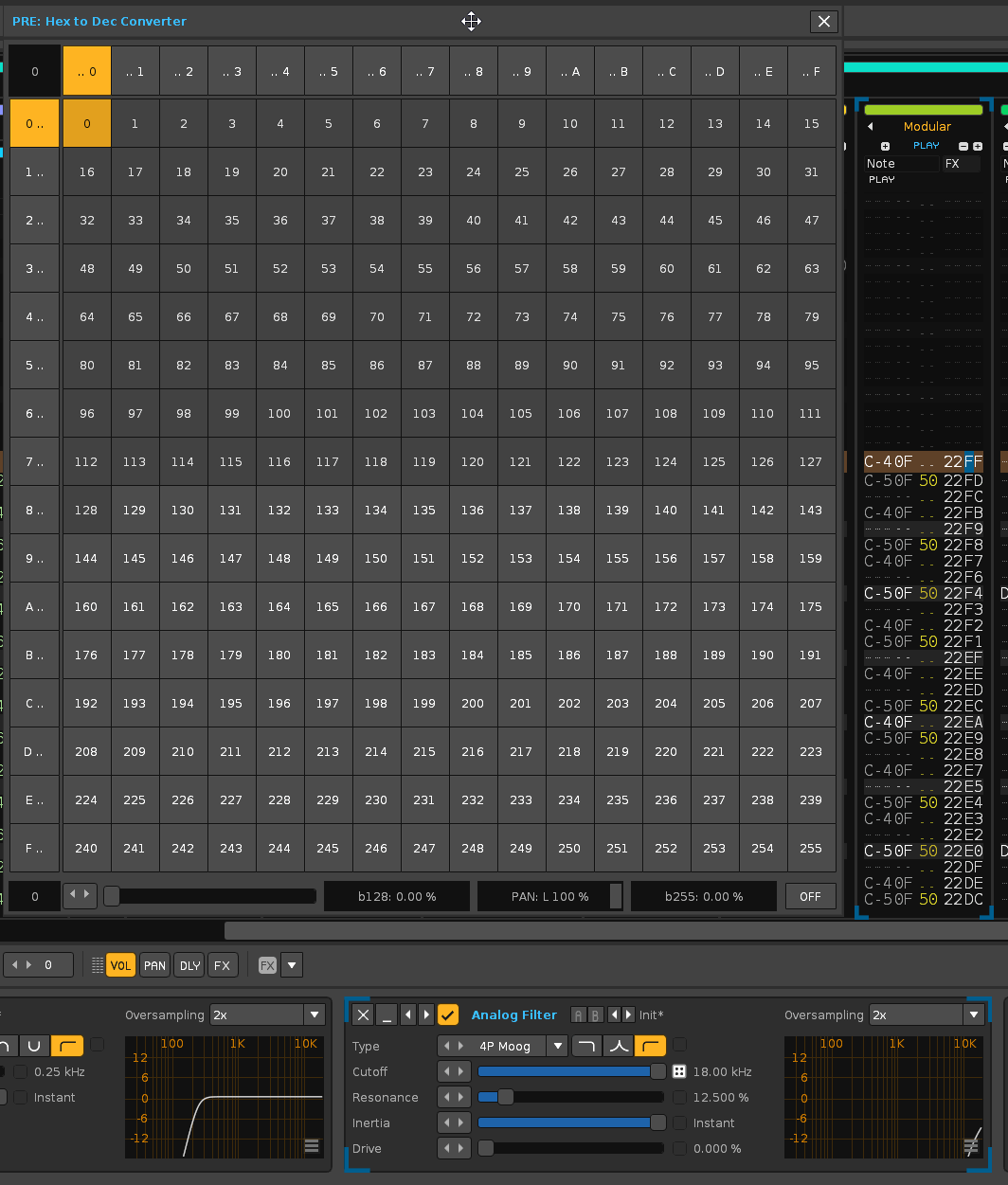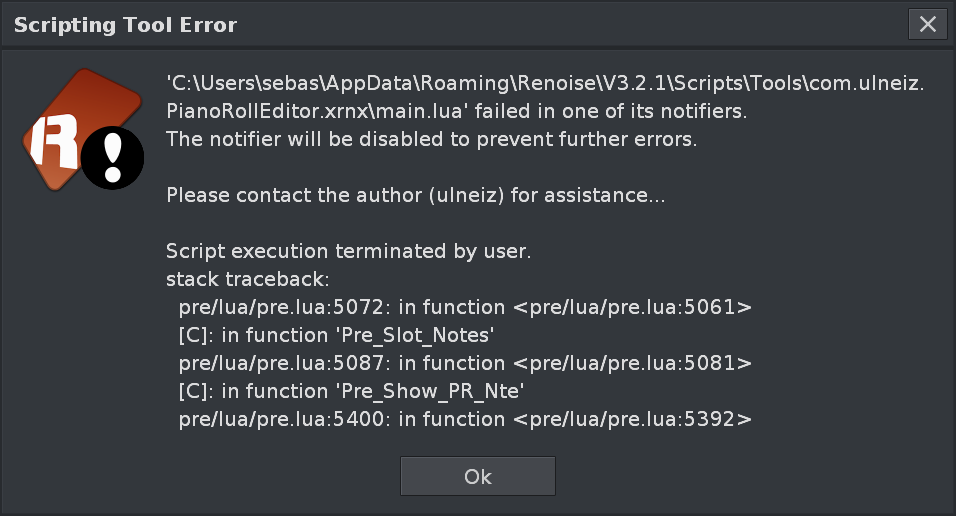Just discovered this tool, and trying to read through the manual, but until I’ve managed to digest all that: does this replace the PhraseTouch tool, or is that a different thing?
The PhraseTouch tool is very different. It is aimed at phrases, among other things. If you have both tools, you will quickly see the differences.
If everything goes fine, I plan to launch version 7 of the PRE in November. Among other things, it will bring some improvements in the manual, for a more enjoyable reading.
That sounds great! Are you also still working on PhraseTouch, then, or is that basically as done as it realistically needs to ever be and there’s no need to add anything to it anymore?
Hi I’d like to purchase a license for Piano Roll Editor.
Hi @xelium, Thanks you! Read your inbox…
Got the full version, absolutly worth the money. Complex tool but very useful. I use it for chords at the moment but i’m sure it can do more, haven’t explored all features yet.
@Raul: It’s more a personal thing, but i don’t like that the tabs in the settings jump. If you in the “preferences”
section, the tabs are at the bottom but in all other sections (about, keyboard commands…) the tabs are at the top. I personally would prefer if they are always at top or at the bottom.
I also have a feature request, if this is even possible without re-programming the whole tool. It would be great if PRE could also be used for Phrases. PRE is great for creating chords, it would be cool to create them as Phrase and safe them for later use. If it is very hard to implement, i’m fine without the possibility and will copy the notes/chords to the Phrase section and save it.
Edit: Oh, and would it be possible to add HEX format for the time line?
Yes, I can change that. I will put all the eyelashes above. This was created in version 1 and evolved in another way. It is possible to change it. Everything that is easy to use is welcome.
Unfortunately, I believe that OSC cannot be used directly with phrases. I’m not sure. Then, everything that involves entering notes or editing them must be done in the pattern editor (always speaking from the tool).
But there is a much easier way to work with phrases.
What if you create a phrase in the pattern editor? There may be 2 buttons (or better yet, 2 menu accesses) to “move phrases” between the pattern editor and the phrase editor. How would it work?
Steps:
- You create a phrase in a track within the pattern editor.
- Select a instrument in instrument box.
- Right click on the track, Track / “Export to Phrase Editor”
This will create a new phrase in selected instrument if the new index is less than or equal to 126. The content will be identical to the pattern-track.
The opposite case, from the phrases editor:
- Select a phrase created in a instrument.
- Right click on the phrase, Phrase / “Export to Pattern Editor”.
It would even be possible to create several phrases in a pattern, each on a track, and accumulate them in the selected instrument with a single action. In this way, you can create phrases, make them sound from the pattern editor, and when you are sure to finish it, export it to the phrase editor. All this from the PRE.
These details really should be native. But it is possible to create tools.
This is already implemented. Go to “Preferences / Miscellaneous” and “Line number format: [HEX] [DEC]”
…
Maybe I integrate everything mentioned for the next version (the tabs and the export phrases).
Sounds good, thank you.
For me it is not really necessary to have such possibility in PRE. I still can use the “Create Phrase from Selection” in the context menu of the Pattern Editor as usual to transfer Phrases from the Pattern Editor to the Phrase Editor. I personally don’t necessarily need to transfer Phrases from the Phrase Editor to the Pattern Editor. The possibility to enter notes/chords directly from PRE into the phrase editor just would save the “transfer action” and would make it a bit nicer and more undisruptive while working on a project.
Everyone has a different workflow, but for me, Phrases are a huge help to keep the overview, especially when working with chords. It makes a huge difference to have, say eight columns in the pattern editor with Phrases or fourty without Phrases. I usually just name a track, pick the instrument of choice, enter one note and then switch to the Phrase Editor to build lines, melodies or chords. I use the Pattern Editor mainly for drums and when working with samples, everything “melodic” instrument related (native, VSTi) are sequenced with the Phrase Editor. I may enter some notes in the Pattern Editor afterwards to vary/transpose the lines, melodies or chords.
Thank you, found it.
The PRE tool depends on the available API. This API does not give direct access to be able to edit directly in the Phrase Editor. That is, it is not possible to use OSC messages to play notes (sound) and thus be able to edit them in the Phrase Editor (add/delete notes).
In fact, as far as I know, the API for the phrase editor “is incomplete”. It is not as advanced as for the Pattern Editor. Moreover, if you select the Phrase Editor, PRE cannot record any, because the Pattern Editor is not selected. In this case, from the PRE, the OSC messages will play the constructed phrases, even if you have the Phrase Editor with the “edit mode” enabled.
It is as if the API was prepared to expand things, but there is a lack of content so that the tool programmer can work extensively with the phrases (edit in the Phrase Editor through OSC). I don’t know if there is any “hidden” direct way of doing it. If there is, let expert someone comment.
I am referencing Renoise 3.2.0 / 3.2.1 at all times…
For trigger notes, inside OSC exists this messages (used in the PRE):
/renoise/trigger/note_off(number,number,number)
/renoise/trigger/note_on(number,number,number,number)
This only works with the Pattern Editor. There are no 2 equivalent messages that do the same but only for the Phrase Editor. Therefore, it is not possible to add this way of operating.
If you have a phrase with a note in the first column of the first line, you can get the value of the note:
print(renoise.song().selected_phrase:line(1):note_column(1).note_value)
If it is C-4, the note_value = 48
That is, it is possible to enter the notes in the Phrase Editor, but not from OSC:
renoise.song().selected_phrase:line(1):note_column(1).note_value=48
or the note-OFF:
renoise.song().selected_phrase:line(1):note_column(1).note_value=120
or clear the note:
renoise.song().selected_phrase:line(1):note_column(1).note_value=121
But the notes will not sound! Renoise (and your API) is not yet designed/finished for this. The only way from the API to sound the notes is to use OSC.
By the way, in the API I think there is no “selected_line” for the Phrase Editor. Have I missed something? This prevents locating the current line to be able to edit over it. Everything seems to indicate that the API is incomplete for editing phrases.
The PhraseTouch tool has not been developed for a long time. I am currently concentrating on keeping the Piano Roll Editor tool, which is a lot of work.
The PhraseTouch tool stayed for version 3.1.1 of Renoise. To update it I should review it and also add / edit a lot of additional (larger) icons to make it compatible with Renose 3.2.0 (and following), and its GUI scaling.
Thank you for the detailed explanation. Maybe there will be a update to the API someday, until then i’ll use PRE in the Pattern Editor. Nevertheless, PRE is pretty cool!
New development of the Phrase Manager module for the PRE:

This is a developing beta version. Basically it is a phrase manager, to quickly manipulate its main features and be able to see data from several phrases at once.
It will allow you to select several phrases to export in a folder, import an entire folder of phrases (up to the first 126), rename phrases individually or the selected set, export / import data between the pattern editor and the phrase editor.
This tool does not serve to edit phrases (within the phrase editor, which, from what I have seen and achieved, cannot be developed). But it will help to better manage their main characteristics and have a global vision of the phrases together, quickly locate and identify the phrases by name and be able to compare differences between duplicates.
I hope this window is an integrated part of the PRE, although its development is being worked entirely separately.
For those interested in phrases, suggestions are accepted!
New look of the Phrase Manager. The image says it all…

Added the ON / OFF button for the “Hex to Dec Converter” module, for PRE7.

This allows you to analyze hexadecimal values (convert to decimal) in the following sub-columns (for all types of tracks, only for the pattern editor):
Inside of the note column:
- note
- instrument
- volume
- panning.
- delay.
- sfx amount.
Inside of the effect column:
- effect amount.
Related topic: Dec Hex conversion
Now that we have version 3.2.1 of Renoise, I hugely announce that the new version 7.0 of Piano Roll Editor as just published! Read the first comment for more information. To know all the news, display the list of the new version in “Update History”.
To update the tool to the latest version for all those users who have their **Personalized Use License of Full Version**, please follow this steps:- Uninstall the old version of PRE.
- Install the latest version of PRE.
- Reinstall your Personalized Use License.
Other considerations:
- Remember to backup your custom chord banks, before reinstalling the tool, so you do not lose them.
- For the rest of users, they can try the free Demo Version.
Piano Roll Editor 7 includes some interesting news, as well as some corrections and improvements. The User Guide has also been improved to make reading more enjoyable, including color labels.
PRE7 now comes with a new “independent” window tool, the Phrase Manager. If you use the phrases regularly, you will appreciate this tool. I have wasted a lot of time programming this.
The Hex to Dec converter window tool, now includes a new on / off switch, to synchronize the table with the cursor of the pattern editor, for the sub-columns of values.
Another interesting thing is that PRE7 now includes the ability to jump lines between notes (skip to the next or previous note). In addition, it includes a new function to sort notes stacked, among other things…
Please, if in doubt, take a look at the user guide. There are many novelties there…
If you are interested in the Full Version of PRE and in supporting the developer, get your Personalized Use License!
Thanks for the support and enjoy it!
@Raul I downloaded from your website, but want to let you know that the download link points to the manual.
Also, i installed the last PRE version and get a hangup if i start PRE.
Termination gives…
If i let the script run, it takes another second and then seems to run fine.
Yes, my mistake, I simply did not update the download identifier correctly, I got confused. It is already corrected. Thanks for notifying!
I would like to test this situation in version 3.1.1. I think that version 3.2.0 / 3.2.1 seems to be a bit more restrictive with the execution time limit of a chain of functions.
The code really is fine. Simply, on slower CPUs it will take longer to perform the first load and Renoise will show that “busy error”.
What exact CPU model are you using? Can it be an Intel i3 or similar?
At the moment, you can ignore that window and press the “NO” button.
PRE7 load is the same as version 6. I have only added a separate LUA file that will not load its part of the GUI on the first load, because it is a different window.
I suspect that the compatibility of larger GUI scaling needs more time to load. And that is because Renoise has changed, and with it the compatibility of the GUI scaling tool.
I will investigate this, to see if I can optimize it in some way.
It works on Linux. Haven’t had the possibility to test on Windows yet, but i guess it will work, too. I’ll let you know if it doesn’t. Thank you!
Solved then! In Windows it should work exactly the same as in Linux. The PRE tool use exactly the same code. If there is any difference, it will not depend on the tool. With the current download package, the “busy window” will not appear.
Yes, please, when you can do a test under Windows, see if it works correctly. Thus we eliminate doubts. It is better to try more machines.
@spktkpkt Can you tell me which CPU model you use? I could use to know for have all these things under control for the future…
Of course, sorry.
The current Linux system has a Dual-Core Intel® Core™ i5-2520M CPU @ 2.50GHz
I’ll let you know the CPU of my other Windows system when i have tested PRE on it.
EDIT: @Raul, testet on Windows, works fine. This system has a Intel(R) Core™ i7-8750H CPU @ 2.20GHz


